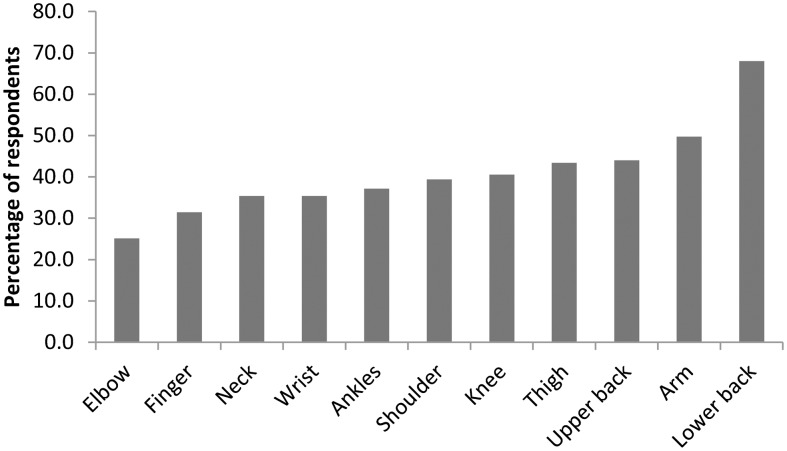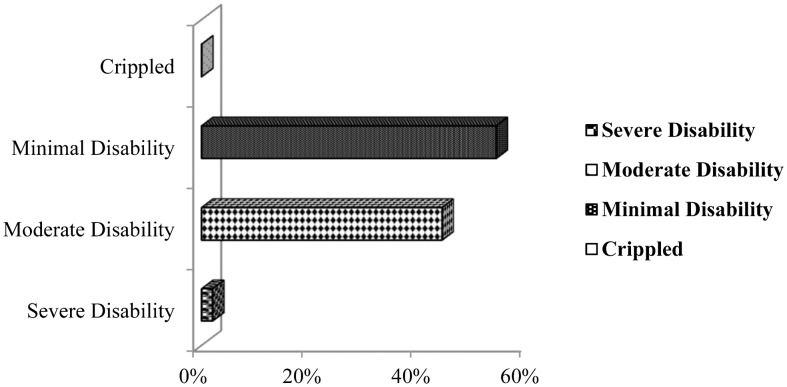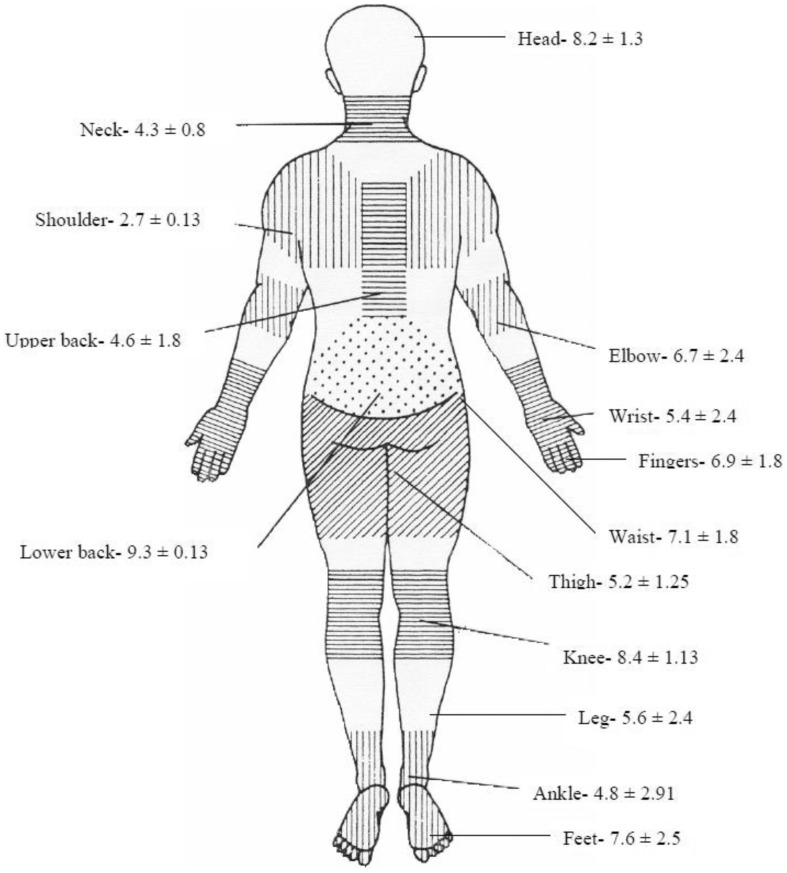Abstract
Background:
Handloom is one of the oldest industries in India, particularly in West Bengal, where a considerable number of rural people are engaged in weaving.
Objectives:
The purpose of this study was to evaluate the prevalence of low back pain among the handloom weavers in India.
Methods:
A modified Nordic Musculoskeletal Disorder Questionnaire and Oswestry Low Back Pain Disability Questionnaire along with a body part discomfort scale were administered to handloom weavers (n = 175). Working posture of the participants was assessed using the Ovako Working Posture Analysis System (OWAS).
Results:
Sixty eight per cent of the participants reported suffering from low back pain, making it the most prevalent disorder in our sample. Analysis of the Oswestry Low Back Pain Disability Questionnaire data revealed that among those with low back pain (n = 119), 2% had severe disabilities, 46% had moderate disabilities, and 52% had minimal disabilities. Statistical analyses revealed a positive significant association between the intensity of pain in the lower back and an increased number of years of work experience (P<0.05).
Conclusions:
The study underlines the need for further research regarding the postural strain of weavers and also suggests the implementation of ergonomic design into weaver workstations to minimize the adverse effect of their current working postures. Improving upon the weaver’s work-posture could improve their quality of life.
Keywords: Informal sector, India, Handloom weavers, Low back pain
Introduction
Handloom weaving is one of the oldest industries in India, particularly in West Bengal, where approximately 400 000 people are engaged in this informal sector activity.1 On average, weavers are of a low socio-economic status and although they are occasionally eligible to receive government aid to purchase handloom and raw materials, this assistance is not sufficient to sustain long-term business. Moreover, many weavers do not own a handloom and instead, work for the weavers who do own weaving equipment. Inadequate salaries and lack of equipment result in people having to work long hours to meet basic food and housing needs.2
Handloom weaving involves manually sorting raw materials, carding and spinning with a cord machine, and dyeing the fibers with acid and chrome. Pre-weaving, fibers are boiled in an acetic acid and dye solution, washed in running water, and dried. Weavers use hand-operated looms that require the weaver to sit at the loom and operate foot pedals that hang below. These actions require repetitive movement of the upper and lower limbs to operate pedals and shuttles with the arms raised away from the body. Post-weaving activities include clipping threads, embossing and carving art designs, mending, edge bending, and chemical washes to produce the finished product. In addition to awkward positions, workers are exposed to noise and dust pollution during these processes.
Long work hours and strenuous activities put weavers at risk for work-related musculoskeletal disorders (WMSDs), predominantly low back pain (LBP). WMSDs are a major health problem among workers in both industrialized and industrially developing countries.3,4 Previous reports suggest that Indian handloom weavers have a high prevalence of pain.2,5 Studies in Iran with workers in the carpet weaving industry have found a high prevalence of musculoskeletal problems due to working postures, poor tool (loom) design, long hours, repetitive work, and seat type.6,7
Studies with other unorganized worker populations suggest that low back pain is a common problem in the informal sector. A study among brick and construction workers in West Bengal, India found that more than 80% of female workers complained of back pain.8 Moitra et al. found that in West Bengal, India among 120 male goldsmiths, 43.8% reported low back pain.9 Sahu and Sett reported that the percentage of WMSDs were high among male jute hacklers (i.e. the jute mill workers who sorted out the jute bundles) (92.5%) of West Bengal.10
The aim of this study was to evaluate the prevalence of LBP among handloom weavers in West Bengal, India. There is a dearth of knowledge regarding the postural strain of weavers in this region. With such a large number of rural workers involved in this profession, minimizing the occupational hazards through improved workplace ergonomics will increase work efficiency, production, and workers’ quality of life.
Methods
Study participants
For the purpose of this study, self-employed handloom weavers were selected using a simple random sampling method. The names of all the weavers who were eligible for the study were written on small pieces of papers. From these pieces, 175 weavers were randomly selected by lottery system. The investigator explained the aims of study to these weavers in layman terms.
Inclusion criteria for the participants included having worked for a minimum of 5 years as a weaver. Weavers were excluded if they reported a previous history of occupational injury. Ethical approval for this study was obtained from two institutional ethical committees: the University of Calcutta and Departmental Research Committee, University of Kalyani.
Data collection
The height and weight of participants were measured with an anthropometer and weighing scale (scale in kilogram) and the Body Mass Index (BMI) was computed.11,12
A modified Nordic Musculoskeletal Questionnaire was administered to participants.13,14 The questionnaire was modified to be administered orally to meet the literacy needs of respondents. The Oswestry Low Back Pain Disability Questionnaire was administered to the subpopulation of weavers who reported experiencing low back pain on the modified Nordic questionnaire.15
Posture analysis
Working postures of weavers were analyzed in the laboratory using the Ovako Working Posture Analysis System (OWAS).16 Observations were made multiple times during the cycle of a particular task. The most commonly held postures were used for postural analysis in every participant.
Statistical analysis
Data were analyzed using the statistical package SPSS version 20. Analysis included calculation of the means and standard deviations for physical parameters. The weavers were divided into three different groups based on their working experience: 5–15 years; 16–25 years; and 26–35 years. Analysis of variance was used to test for significant difference between the three working experience groups. Chi-squared analysis was used to test for associations between the occurrence of pain symptoms and years of working experience.
Results
Demographics
Demographic data of the study population, including age, weight and height, BMI, and regular working hours by years of experience, are provided in Table 1. On average, participants had worked 16.2±7.3 years and had a regular daily work schedule of 10.0±2.9 hours. All participants reported working 7 days a week. Analysis of variance analysis showed no significant differences in height, weight, or BMI by years of working experience.
Table 1. Demographics of the study population (n = 175).
| 5–15 years (n = 93) | 16–25 years (n = 57) | 26–35 years (n = 25) | F value* | Significance (P<0.05) | |
| Age (years) | 27.4±5.6 | 39.5±5.5 | 46.2±4.6 | 161.7 | SIG. |
| Height (cm) | 162.1±5.3 | 161.9±4.9 | 162.0±5.3 | 0.1 | NS |
| Weight (kg) | 57.8±9.0 | 57.8±8.6 | 57.6±9.7 | 0.1 | NS |
| BMI (kg m−2) | 22.2±3.4 | 22.1±3.6 | 21.9±3.3 | 0.2 | NS |
| Experience (years) | 16.2±7.3 (n = 175) | NA | NA | ||
| Regular working hours | 10.0±2.9 (n = 175) | NA | NA | ||
Note: NS: not significant; NA: not applicable; SIG: significant.
*F value is the ratio between the “between group variability” and “within group variability”. This statistics follows an F-distribution If the computed F value is larger than the critical F value, the null hypothesis is rejected.
Prevalence of LBP
Figure 1 shows the results of the Nordic Questionnaire analysis. The analysis revealed that the most affected body part was the lower back (68%), followed by arm (49.7%), upper back (44%), knee (38%), shoulder (39.4%), wrist (35.4%) and neck (35.4%). Figure 2 shows the results of the Oswestry Low Back Pain Disability Questionnaire analysis. We found that 2% of the participants reported severe disabilities, 46% reported moderate disabilities, and 52% of the participants reported minimal disabilities.
Figure 1.
Pain by body part in handloom weavers (n = 175).
Figure 2.
Analysis of Oswestry Low Back Pain Disability Questionnaire.
Association between pain and years of experience
Table 2 shows the results of the Chi-square analysis. We found a positive, significant association (P = 0.02) between the intensity of low back pain and an increase in years of work experience. No other body parts showed a significant association with years of work experience.
Table 2. Relation between pain intensity in different body parts and years of experience of the participants.
| 5–15 years (n = 93) | 16–25 years (n = 57) | 26–35 years (n = 25) | Chi-square | P value | ||
| LBP | Yes | 67 | 41 | 11 | 7.72 | 0.02* |
| No | 26 | 16 | 14 | |||
| Neck | Yes | 31 | 23 | 8 | 0.91 | 0.63 |
| No | 62 | 34 | 17 | |||
| Shoulder | Yes | 39 | 23 | 7 | 1.63 | 0.44 |
| No | 54 | 34 | 18 | |||
| Elbow | Yes | 25 | 14 | 5 | 0.51 | 0.77 |
| No | 68 | 43 | 20 | |||
| Wrist | Yes | 37 | 20 | 5 | 3.37 | 0.18 |
| No | 56 | 37 | 20 | |||
| Upper back | Yes | 41 | 27 | 9 | 0.91 | 0.63 |
| No | 52 | 30 | 16 | |||
| Knee | Yes | 37 | 25 | 9 | 0.49 | 0.78 |
| No | 56 | 32 | 16 | |||
| Ankles | Yes | 33 | 23 | 9 | 0.37 | 0.83 |
| No | 60 | 34 | 16 | |||
| Arm | Yes | 45 | 31 | 11 | 0.89 | 0.64 |
| No | 48 | 26 | 14 | |||
| Thigh | Yes | 40 | 25 | 11 | 0.01 | 0.99 |
| No | 53 | 32 | 14 | |||
| Finger | Yes | 29 | 18 | 8 | 0.00 | 0.99 |
| No | 64 | 39 | 17 |
Note: *P<0.05.
Table 3. Analysis of handloom weaver’s posture while working (n = 175).
| Serial No. | Posture | OWAS code | Risk | Action to be taken |
| 1. | 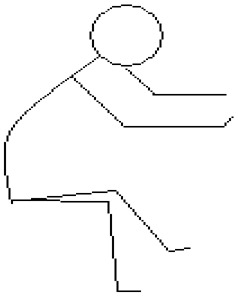 |
2, 1, 7, 2 | Harmful | Corrective action should be taken immediately |
| 2. | 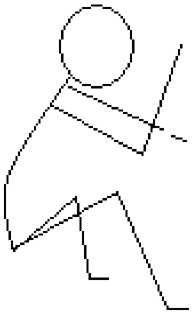 |
2, 1, 7, 1 | Harmful | Corrective action should be taken immediately |
| 3. |  |
4, 1, 7, 1 | Harmful | Corrective action should be taken immediately |
| 4. | 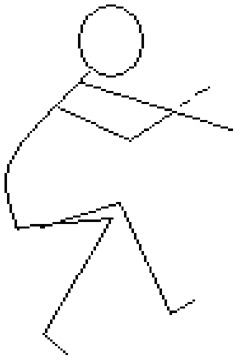 |
2, 1, 7, 2 | Harmful | Corrective action should be taken immediately |
Discussion
Even in our modern times, the traditional cultural activity of handloom weaving is invaluable, and it is essential that weavers are sufficiently cared for and valued as artisans and employees. Moreover, this profession provides the livelihood of a large section of the working population in West Bengal. This study is important not only from the occupational health and financial point of view of the weavers, but also for the sustenance of the aesthetic and cultural value of the handloom weaving profession.
This study presents evidence confirming that the work of weavers is strenuous. Consequently, the weavers suffer from musculoskeletal disorders arising from of a number of reasons — the most relevant being the adoption of a constrained sitting posture for prolong time periods. Among those experiencing musculoskeletal disorders, the most common complaint was LBP. Results from the Body Parts Discomfort (BPD) Scale (Fig. 3) also showed that discomfort in the lower back portion of the body was common among handloom workers. BPD ratings in knee, feet, and waist of the workers were also high. Previous studies have found significant associations between the prevalence of LBP and occupations that require static sitting.17,18 The Oswestry Low Back Pain Disability Questionnaire analysis indicated that participants classified as having minimal disabilities can cope with most daily activities and makes no recommendations for intervention beyond providing advice on proper lifting, sitting, and exercise. Participants with moderate disabilities likely have more difficulty sitting, lifting, and standing, which typically impact their travel, social, and work lives. For people with moderate disabilities, personal care and sleeping are not grossly affected and pain can typically be managed by relatively simple means such as letting them perform stretching exercises and making them aware of the importance of back rest. For people with severe disabilities, pain is a major problem affecting daily activities. These participants require immediate attention and intervention.
Figure 3.
Different discomfort zones of the body as per the Body Part Discomfort (BPD) Scale.
Another finding is the significant association between the intensity of low back pain and the number of years of work experience. This finding is in agreement with prior research. In a previous study with weavers, Banerjee and Gangopadhyay found a significant correlation between pain intensity and years of experience, with people employed for longer periods reporting more pain.4
Analysis of the workers weaving postures revealed that the adopted postures were harmful, indicating that corrective measures should be implemented immediately. The pain commonly experienced in the back, knees, and feet is likely explained by the repetitive nature of the work and from maintaining static positions for long time periods. Similar observations were found among the weavers of West Bengal, India by Sahu et al.2
The primary findings from this study regarding the occupational risks that likely lead to the high prevalence of musculoskeletal disorders among handloom weavers include: a bent back due to low loom position, insufficient workspace for proper movement (Fig. 4), workspace constraints, muscle exertion, and the repetitive movement of limbs to operate the looms.19 Nag et al. found that among loom weavers, WMSDs result from an interaction between several stressors associated with work and work environment. Prior studies have found that the non-adjustability of loom workstations place constraints on workers due to anthropometrics and physiological characteristics, contributing to the development of musculoskeletal disorders.20
Figure 4.
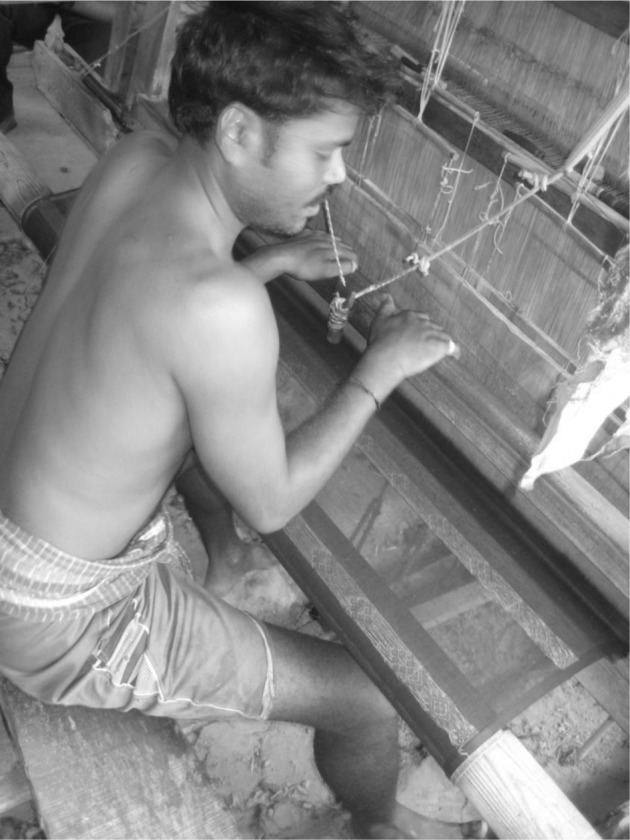
Actual working posture of handloom weaver.
Therefore, the elimination of factors that likely contribute to the weavers’ suffering is the prime need of the hour. Since prolonged sitting has been documented to be a strong risk factor affecting the musculoskeletal system in these settings, weavers should introduce frequent rest pauses between two consecutive work cycles by taking short breaks. Moreover, a lumbar support, which can be adjusted in height and thickness, may provide some relief from persistent LBP. Recommendations can be shared with weavers through periodic training programs wherein they can compare their current working conditions to potential improvements. Implementation of such training programs will also provide opportunities to monitor the implementation and regular practice of recommendations.
The unorganized sectors in India support the growth and development of the nation’s economy. Approximately 93% of the Indian workforce is engaged in some type of unorganized sector work.21 We studied one such unorganized sectors in West Bengal, India. In India, there are no regulated or normal working hours, resulting in long work hours in order to secure extra income. Awareness about WMSDs and their impacts on workers health and productivity are absent among workers. The unorganized work sector is also outside the scope of occupational safety policies or health assessment programs that employees in the organized sector may benefit from. More research into the occupational health hazards faced by employees in the unorganized sector is a necessary starting point to improve the working conditions of these workers.
Disclaimer Statements
Contributors SD: collect and analyse the data; SC: help in analysis of data; AC: help in collection of data; TD: drafted the paper.
SD: analyze the data; SG: edited the draft; PH: Help in collection of data and drafted the paper; SGM: help in collection of data; KS: help in analysis of data; SS: planning of the study and finalize the draft.
Funding None.
Conflicts of interest None.
Ethics approval The Study was approved by Deparmental Research Committee, Department of Physiology, University of Kalyani and human ethics committee, Department of Physiology, University of Calcutta.
Acknowledgments
Authors express their sincere gratitude to the handloom weavers who kindly cooperated in the completion of this study.
References
- 1.Ministry of Textiles, Government of India. Third National Census of Handloom Weavers and Allied Workers. New Delhi: Development Commissioner (Handlooms), Ministry of Textiles, Government of India; 1997. Available from: http://handlooms.nic.in/handloom_census_2009-10.pdf, accessed on 11.12.2013. [Google Scholar]
- 2.Sahu S, Sett M, Durlov S. An ergonomic study on the musculoskeletal disorders among the male handloom weavers of West Bengal, India. Ind J Appl Physiol Allied Sci. 2012;66(1):16–27. [Google Scholar]
- 3.Westgaard RH, Winkel J. Ergonomic intervention research for improved musculoskeletal health: a critical review. Int J Ind Ergon. 1997;20:463–500. [Google Scholar]
- 4.Banerjee P, Gangopadhyay S. A study on the prevalence of upper extremity repetitive strain injuries among the handloom weavers of West Bengal. J Human Ergol. 2003;32:17–22. [PubMed] [Google Scholar]
- 5.Pandit S, Kumar P, Chakrabarti D. Ergonomics problems prevalent in handloom units of North East India. Int J Sci Res Publications. 2013;3:1–7. [Google Scholar]
- 6.Choobineh A, Lahmi M, Shahnavaz H, Jazani R, Hosseini M. Musculoskeletal symptoms as related to ergonomic factors in Iranian hand-woven carpet industry and general guidelines for workstation design. Int J Occup Saf Ergon. 2004;4:157–68. doi: 10.1080/10803548.2004.11076604. [DOI] [PubMed] [Google Scholar]
- 7.Choobineh A, Lahimi M, Hosseini M, Shahnavaz H, Jazani K. Musculo-skeletal problems in Iranian handwoven carpet industry. Appl Ergon. 2007;38:617–24. doi: 10.1016/j.apergo.2006.06.005. [DOI] [PubMed] [Google Scholar]
- 8.Sahu S. Musculoskeletal pain among female labourers engaged in manual material handling task in informal sectors of West Bengal, India. Asian-Pac Newslett Occup Health Saf. 2010;17:58–60. [Google Scholar]
- 9.Moitra S, Maity SG, Sahu S. Assessment of the musculoskeletal problems of the goldsmiths working in unorganized sectors in West Bengal. J Environ Physiol. 2011;4:34–39. [Google Scholar]
- 10.Sahu S, Sett M. Study on work load and work related musculoskeletal disorders among male jute mill workers of West Bengal, India. Work. 2012;41:289–97. doi: 10.3233/WOR-2012-1352. [DOI] [PubMed] [Google Scholar]
- 11.Cole TJ, Bellizzi MC, Flegal KM, Dietz WH. Establishing a standard definition for child overweight and obesity worldwide: international survey. BMJ. 2000;320(7244):1240–3. doi: 10.1136/bmj.320.7244.1240. [DOI] [PMC free article] [PubMed] [Google Scholar]
- 12.Poskitt E. Body Mass Index and child obesity: are we nearing a definition? Acta Pædiatr. 2000;89(5):507–9. doi: 10.1080/080352500750027745. [DOI] [PubMed] [Google Scholar]
- 13.Kourinka I, Johnson B, Kilbom A, Vinterberg H, Beiring-Sorenson F, Anderson G, et al. Standardised Nordic questionnaires for the analysis of musculoskeletal systems. Appl Ergon. 1987;18(3):233–7. doi: 10.1016/0003-6870(87)90010-x. [DOI] [PubMed] [Google Scholar]
- 14.Sett M, Sahu S. Ergonomic evaluation of the tasks performed by the female workers in the unorganized sectors of the manual brick manufacturing units in India. Ergonomics SA. 2010;22(1):2–16. [Google Scholar]
- 15.Fairbank JC, Pynsent PB. The Oswestry Disability Index. Spine. 2000;25:2940–53. doi: 10.1097/00007632-200011150-00017. [DOI] [PubMed] [Google Scholar]
- 16.Karhu O, Kansi P, Kuornika I. Correcting working postures in industry: a practical method for analysis. Appl Ergon. 1977;8:199–201. doi: 10.1016/0003-6870(77)90164-8. [DOI] [PubMed] [Google Scholar]
- 17.Gangopadhyay S, Dev S. Effect of low back pain on social and professional life of drivers of Kolkata. Work. 2012;41:2426–33. doi: 10.3233/WOR-2012-0652-2426. [DOI] [PubMed] [Google Scholar]
- 18.Sarna T, Shukla A. A study of physical-health and neuroticism among women engaged in the home-based production of chikan embroidery. Soc Indic Res. 1994;32:179–91. [Google Scholar]
- 19.Nag A, Vyas H, Nag PK. Gender differences, Work stressors and musculoskeletal disorders in weaving industries. Ind Health. 2010;48:339–48. doi: 10.2486/indhealth.48.339. [DOI] [PubMed] [Google Scholar]
- 20.Bao S, Silverstein S, Cohen M. An electromyography study in three high risk poultry processing jobs. Int J Ind Ergon. 2001;27:375–85. [Google Scholar]
- 21.Ratnam CSV. Social security in the organized sectors in India. In: Report: social development report. New Delhi: Oxford University Press; 2006. p. 136–50. [Google Scholar]



